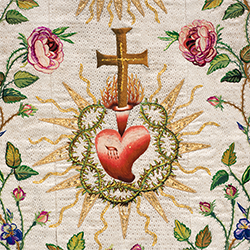
Chasuble.
Lithuania, middle of the 19th c.
Church of St. Bartholomew the Apostle in Ratnyčia.
19th c. Professional versus amateur
The 19th century is characterized by a large variety of styles and techniques. In Lithuania, the persisting tradition of Baroque was reflected in the decoration of liturgical vestments, and the impact of the mid-century Gothic revival in Europe was hardly felt. The back orphrey of chasubles often acquired the form of a cross. Medallions with Christograms, images of saints or the Lamb of God were placed at the intersection of the cross.
Chasubles
The chasuble is the central vestment for the Holy Mass worn by a priest over all the other parts of liturgical clothing. Originating from a Roman conical cloak protecting from cold, it has retained its form throughout the Middle Ages. Its sides gradually became shorter allowing more freedom of movement, until it became similar to a magnificent shield. The 19th–20th century liturgical movements returned the ancient form of a cloak to the chasuble.
Images of Christ and scenes from the Gospel, symbols of faith, floral ornaments
The Easter chasuble adorned with rose and violet blossoms is enriched with multiple symbols of faith. The flaming heart pierced with a spear is a symbol that gained popularity when Pope Pius IX proclaimed the Solemnity of the Most Sacred Heart of Jesus as universal in 1856. The Lamb of God and the Crown of Thorns point to Christ and His suffering. The Eye of Providence is set up in a triangle above.

